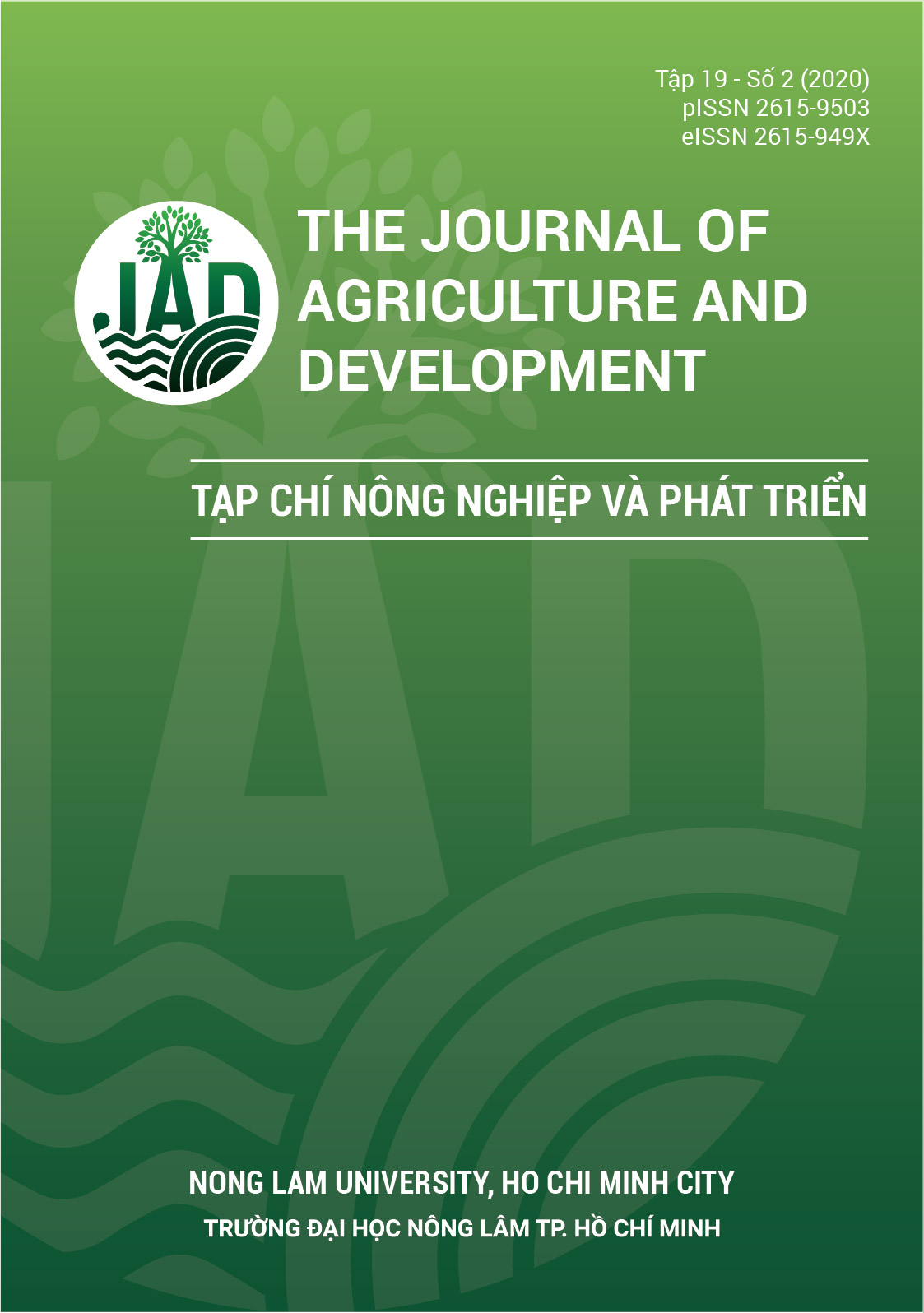Analysis of genetic diversity of 100 cashew (Anacardium occidentale L.) cultivars screened in Binh Phuoc based on nut yield and ISSR markers
Main Article Content
Abstract
Cashew (Anacardium occidentale L.) is an important tropical tree, belonging to Anacardiaceae family and has high economicvalue growing in Vietnam. The objective of this study was to assess genetic diversity of cashew distributed in Binh Phuoc province for breeding development and conservation. A total of 100 cashew samples of over 10 years age distributed in BinhPhuoc province were divided into eight main groups based on nut yield. In contrast, the cluster analysis was divided 100 cashew samples into 12 groups based on 11 ISSR markers. The genetic diversity of 100 cashew samples ranged from 0.04 to 0.26, with a mean of 0.19. The results showed that cashew samples were high levels of polymorphism based on nut yield, as well as the ISSR markers. The results of this research would be one of the important information in the genetic evaluation of cashew trees and useful information for cashew breeding development in future.
Article Details
References
Aliyu, O. M. (2012). Genetic diversity of Nigerian cashew germplasm. In Mahmut Cahskan (Ed.). Genetic diversity in plants. Rijeka, Croatia: In Tech. https://doi.org/10.5772/2640
Anil, K. S., Sanjeev, K., Hemant, S., Ved, P. R., Brahma, D. S., & Sudhakar, P. (2015). Genetic diversity in Indian Snap melon (Cucumis melo var. momordica) accessions revealed by ISSR markers. Plant Omics Journal 8 (1), 9-16.
Bharathi, S. K., Parida, S. K., Munshi, A. D., Behera, T. K., Raman, K. V. & Mohapatra, T. (2012). Molecular diversity and phenetic relationship of Momordica spp. of Indian occurrence. Genetic Resources Crop Evolution 59, 937-948. https://doi.org/10.1007/s10722-011-9735-0
Dasmohapatra, R., Rath, S., Pradhan, B., & Rout, G. R. (2014). Molecular and agro-morphological assessment of cashew (Anacardium occidentale L.) genotypes of India. Journal of Applied Horticulture 16(3), 215-221.
Dey, S. S., Singh, A. K., Chandel, D., & Behera, T. K. (2006). Genetic diversity of bitter gourd (Momordica charantia L.) genotypes revealed by RAPD markers and agronomic traits. Scientia Horticulturae 109(1), 21-28. https://doi.org/10.1016/j.scienta.2006.03.006
Nakasone, H. Y., & Paull, R. E. (1998). Tropical fruits. Oxford, UK: CAB International.
Rasul, M. G., Hiramatsu, M., & Okubo, H. (2007). Genetic relatedness (diversity) and cultivar identification by randomly amplified polymorphic DNA (RAPD) markers in teasle gourd (Momordica dioica Roxb.). Scientia Horticulturae 111(3), 271-279. https://doi.org/10.1016/j.scienta.2006.10.023
Samal, S., Rout, G. R., & Lenka, P. C. (2003). Analysis of genetic relationships between populations of cashew by using morphological characterization and RAPD markers, Orissa, India. Plant Soil & Environment 49(4), 176-182.
Santhosh, W. G., Shobha, D., & Melwyn, G. S. (2009). Assessment of genetic diversity in cashew germplasm using RAPD and ISSR markers. Scientia Horticulturae 120(3), 411-417. https://doi.org/10.1016/j.scienta.2008.11.022
Verma, S., Singh, S., Sharma, S., Tewari, S. K., Roy, R. K., Goel, A. K., & Rana, T. S. (2015). Assessment of genetic diversity in indigenous turmeric (Curcuma longa) germplasm from India using molecular markers. Physiology and Molecular Biology of Plants 21(2), 233-242. https://doi.org/10.1007/s12298-015-0286-2
Vu, T. H., Hoang, H. D., Pham, N. B., & Chu, H. H. (2014). Genetic evaluation of Aquilaria crassna Pierre population in Vietnam using ISSR markers. Journal of Technology and Sciences 30(4), 23-30.








